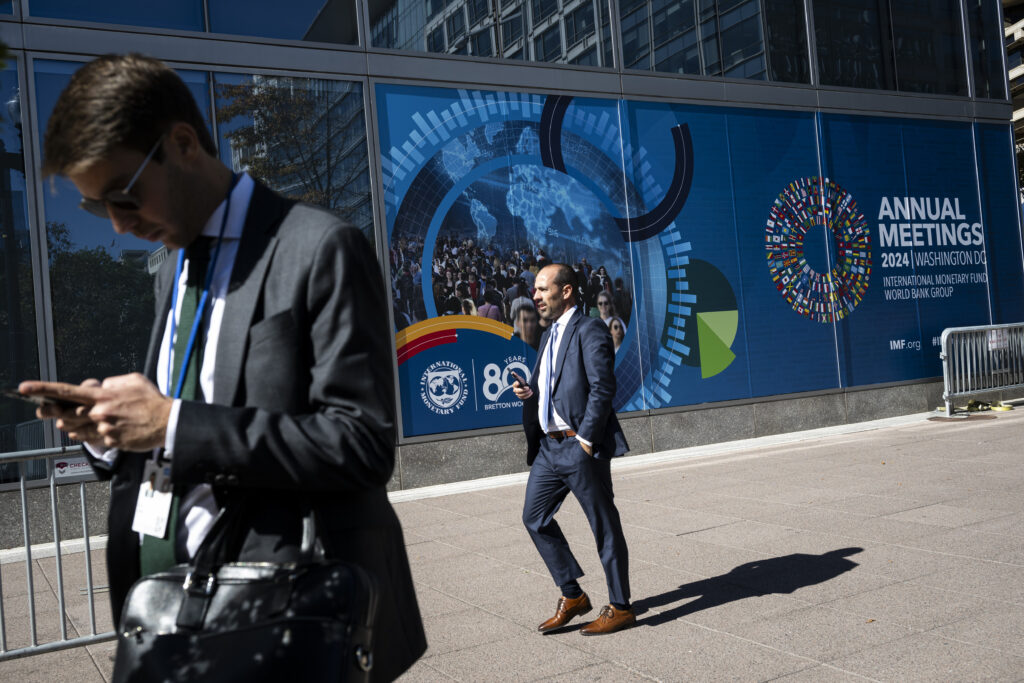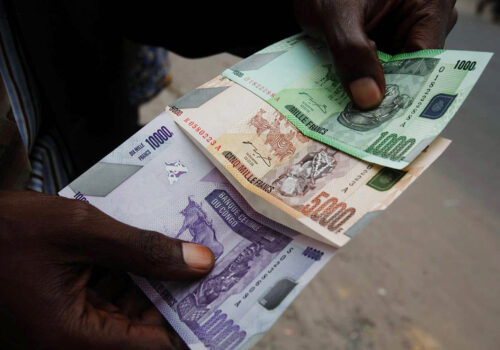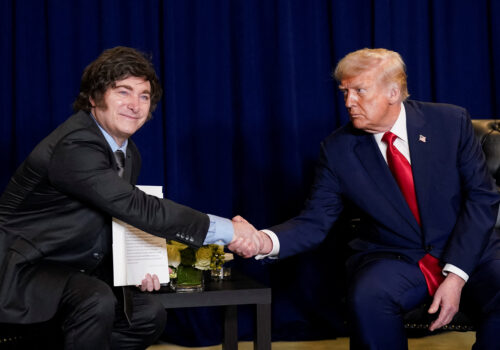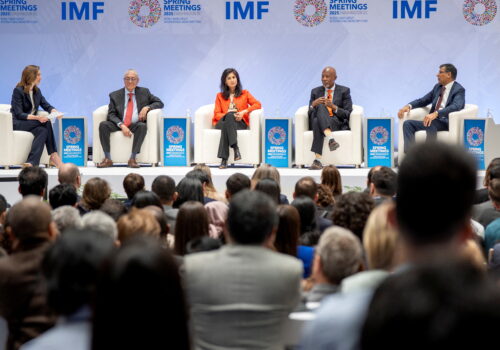The International Monetary Fund (IMF) and World Bank are gearing up for their annual meetings next week. Amid increasingly high stakes, this year’s gathering has special significance, seeing as the United States, after having withdrawn from several other international organizations and agreements, still remains active in the two Bretton Woods institutions.
At these annual meetings, the IMF and the World Bank will face five important issues, which span both near-term economic prospects and more fundamental, longer-term challenges confronting the global economy.
1. Navigating growth—and inflation
Recent data show a rather resilient global economy, particularly in the United States. Despite concerns about rising tariffs and ongoing uncertainty, economic activity has held up since the second quarter of the year—so much so that 2025 gross domestic product (GDP) growth estimates have been recently revised upward, to 3.2 percent globally (according to the Organisation for Economic Co-operation and Development) and 2.5 percent for the United States (according to Goldman Sachs). Stock markets have also performed well, with the MSCI World Index posting a 14.3 percent return year-to-date, roughly matching the S&P 500’s 14.4 percent, though a price-to-earnings ratio of thirty (compared to a long-term average of nineteen) suggests the market valuation could be stretched. Global inflation has slowed noticeably, from 5.67 percent in 2024 to an estimated 4.29 percent this year. In the United States, the consumer price index growth rate fell from 3 percent in January to 2.3 percent in April, before rebounding to 2.9 percent in August.
But this resilience may not last. Evidence suggests that the good performance of the global economy and stock markets has been narrowly based, driven by a handful of high-tech corporations (the so-called Magnificent Seven) pouring money into artificial intelligence (AI) hardware, software, and data centers. In fact, according to JP Morgan Asset Management, AI-related capital expenditures have accounted for 1.1 percent of the 1.6 percent GDP growth in the first half of 2025. Such intensive investment could prove unsustainable, and a slowdown could ripple through the broader economy and stock markets. Meanwhile, US importers are likely beginning to pass more of the costs of tariffs onto retail customers, driving up consumer prices. If new tariffs keep coming, that would sustain the inflation process going forward.
It is up to the IMF to present a convincing analysis of the economy’s vulnerability to concentration risk (dependence on AI related activities) and the likely delayed effects of rising tariffs, which boost the likelihood of mild stagflation in the near future, especially in the United States; it is also up to the Fund to advise countries to adopt policies to mitigate this risk. This could be a challenge, especially when major economies can point to decent economic performance so far this year and may feel complacent.
2. Managing the “dual shock”
Many countries are currently grappling with a “dual shock”: rising US tariffs on one hand and China exporting its industrial overcapacity on the other. In response to declining shipments to the United States, China has redirected exports to third countries, which is set to boost its overall trade surplus to a record $1.2 trillion this year. Put simply, after helping to hollow out the US manufacturing base, Beijing is now starting to do the same to other economies—including Europe and emerging markets that rely on a manufacturing-for-export growth model. These countries are increasingly squeezed by US protectionism and Chinese mercantilism.
How will the IMF guide its members? Will it encourage a “back to basics” approach, based on mutually beneficial policies that reduce external and fiscal deficits, promote free and largely balanced trade, and create growth opportunities for developing countries? Or will it focus on designing second-best solutions—in response to the problems that its two largest member states are creating?
3. Doubling down or easing off on Argentina?
In a scene of déjà vu, the IMF is once again dealing with Argentina’s socioeconomic crisis—shortly after the institution approved its twenty-third assistance package to the struggling nation in April. The twenty-billion-dollar loan comes on top of the $43 billion that Argentina still owes, making the country the largest lending risk exposure of the IMF. President Javier Milei has managed to turn a 5 percent fiscal deficit in 2023 into a 0.3 percent surplus in 2024, and he has reduced annual inflation from nearly 300 percent in early 2024 to under 40 percent today. Argentina’s GDP growth is projected to reach 5.5 percent this year. Yet, Milei’s coalition just suffered a major defeat in an election in Buenos Aires ahead of the midterm polls in late October, shaking investor confidence and triggering a sudden run on the peso, which remains overvalued when adjusted for inflation.
It is not clear how the IMF will deal with the unfolding currency crisis. Will it change its conditionality on the Argentina program to make it more socially and politically sustainable? Or will it double down on the current program, especially given the United States’ promise of a twenty-billion-dollar currency swap line to support Argentina?
4. Dealing with the US administration’s agenda
In line with the Trump administration’s call to the IMF and World Bank to focus on their core missions, the institutions have toned down references to their activities regarding climate change, gender equality, inclusive growth, and sustainable development. It’s unclear, however, whether that will satisfy the United States—or whether Washington will push for even greater compliance with its agenda.
A key question is how the World Bank will respond to US pressure to “graduate” middle-income countries from World Bank borrowing and end lending to China altogether. It also remains to be seen how Daniel Katz, recently approved by the IMF Executive Board to be first deputy managing director, will navigate his new role. Katz, who served as chief of staff to US Treasury Secretary Scott Bessent, has argued that the United States should work to limit China’s role at the IMF and the World Bank—a stance that closely mirrors the administration’s position.
5. Improving the sovereign debt restructuring process
Finally, the IMF and the World Bank have an opportunity to improve the sovereign debt restructuring process. Building on progress in the Global Sovereign Debt Roundtable, the IMF and World Bank should encourage parallel negotiations between debtor countries and their creditors—both official and private lenders—rather than sequential talks. Acting as an honest broker and providing necessary information to both negotiating groups, the IMF could help reduce delays and facilitate timely and fair restructuring agreements.
Participants and observers will closely follow this year’s annual meetings, including these five important issues. Doing so will help them better understand how the United States will continue to interact with other countries in the multilateral setting of the Bretton Woods institutions.
Hung Tran is a nonresident senior fellow at the Atlantic Council’s GeoEconomics Center, a senior fellow at the Policy Center for the New South, a former executive managing director at the Institute of International Finance, and a former deputy director at the International Monetary Fund.
Further reading
Tue, Oct 7, 2025
How a weaker US dollar can help debt-burdened African countries
New Atlanticist By Bart Piasecki
Trump’s drive to weaken the US dollar is having global side effects. For some African countries, it is helping to ease immediate fiscal pressures.
Tue, Sep 30, 2025
Is the US currency rescue for Argentina positive statecraft or reckless favoritism?
New Atlanticist By Martin Mühleisen
A twenty-billion-dollar US support package for Argentina announced last week provides crucial breathing room for President Javier Milei.
Mon, Aug 4, 2025
Trump’s review of US membership in the IMF offers a rare chance for reform
New Atlanticist By Martin Mühleisen
The institution needs its major shareholders aligned to tackle new challenges, and it deserves a management team qualified to lead it on this new path.
Image: Signage for the International Monetary Fund and World Bank Group 2024 Annual Meetings is seen at the IMF secondary headquarters, in Washington, DC, on Monday, October 21, 2024. Photo by Graeme Sloan/Sipa USA via Reuters.




